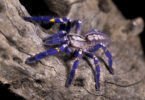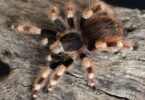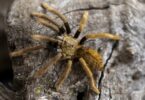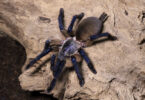Ever felt like your home’s missing a wild touch, maybe something exotic from the lush forests of Brazil? Picture this: the Lasiodora parahybana, a giant among spiders, sporting flamboyant salmon-pink hues.
This blog is your gateway to understanding and caring for one of nature’s most striking spectacles – right in your living room! Get ready; you’re about to step into the fascinating world of tarantulas..
Description of the Lasiodora parahybana
Ah, the Lasiodora parahybana, or should I say, the Brazilian Salmon Pink Tarantula—quite a mouthful but totally worth talking about! This behemoth of a spider is like Mother Nature’s nod to all things grand and theatrical in the arachnid world.
Appearance, Size, and Lifespan
So, you’re curious about the Lasiodora Parahybana, eh? Let’s dive into their looks and how big they get. This arachnid is a real show-stopper with its dark brown body and salmon-pink hairs—yeah, that’s where it gets its nickname.
Imagine seeing one of these guys in full display; females can stretch their legs up to 10 inches wide! Males are no slouches either; they’ve been known to boast an impressive 11-inch leg span.
Now for the long haul—their lifespan might just blow your mind. Females can stick around for as many as 25 magical years. That’s longer than some pets we usually have around! But hold on, males don’t live quite as long, though they still make it past a decade if everything goes well.
What’s wild is this hefty spider scales up quick and can hit adult size in just three years flat! And let me tell ya, with some tipping the scales at over 100 grams (that’s more than a quarter-pound burger!), these tarantulas are not only fascinating—they’re formidable too!
Habitat
The Brazilian Salmon Pink Tarantula, oh boy, it’s a real ground-dweller. It loves the down-low life in Eastern Brazil’s tropical rainforests, where it’s warm and the air feels like a wet blanket – humidity is their jam! These big spiders don’t bother with tree life; they’re all about burrowing and chilling on terra firma.
Now picture this: an arachnid designed for stealth and comfort in an environment that’s basically a giant greenhouse – pretty snazzy if you ask me.
In their neck of the woods—scratch that—ground, these fuzzy fellas are right at home among leaf litter and cozy nooks on forest floors. They thrive where most folks would throw in the towel because of the heat.
A spider that digs high humidity? Yeah, sounds about right for these tropical rainforest climate lovers. Next time you find yourself daydreaming about exotic pets or planning your terrarium setup (you know who you are), give a thought to how rad these eight-legged wonders are, living it up in their steamy paradise!
Behavior and Venom Potency
Brazilian salmon pink tarantulas are pretty chill most of the time. They hang out and do their thing, but if you bug them too much, they might give you a nip. Their venom won’t land you in the hospital, but it’s their way of saying “back off!” Now, these big hairy spiders have another trick up their sleeve—or should I say leg? If they feel threatened, they’ll kick urticating hairs from their belly that can really irritate your skin or eyes.
Ouch! It’s like their own form of pepper spray.
So let’s talk bites. Sure, getting bitten by one isn’t fun—these fangs are of substantial size—but for most folks, it’s nothing to lose sleep over (unless you’re allergic; then you gotta be extra careful).
Remember this: these tarantulas don’t go around looking for trouble. Give them some space—no poking or prodding—and chances are they’ll keep to themselves just fine. Keep calm around them and enjoy watching—one of nature’s eight-legged wonders doing its thing!
Enclosure Requirements for Lasiodora Parahybana
Alright, fellow tarantula enthusiasts, let’s talk digs for our eight-legged friends – specifically the Lasiodora parahybana. These Brazilian beauties need a pad that’s just right to kick back and relax in…and we’re talking more than just tossing in a few twigs and calling it a day!
Terrarium Specifications
So you’ve got yourself a Brazilian Salmon Pink Tarantula, huh? That’s awesome! But now, let’s talk about their home – the terrarium. These spiders need space to show off their moves and stay cozy. Here’s what you gotta know about setting up their pad.
- Pick a wide enclosure with enough substrate for burrowing. Your eight-legged friend loves to dig, so make sure there’s at least 2/3 height of the terrarium filled with substrate.
- A 10-gallon tank is great for a 7-inch spider. This size gives them room without making them feel lost.
- Inside their home, they need a half – log hide. It’s like their secret base where they can chill out and have some “me time.”
- Floor space matters – aim for at least 12×12 inches. Think of it as their playground; more room means happier spiders.
- Keep in mind, these critters are ground-dwelling. They’re not the tree-hugging type, so focus on floor area rather than height.
- The enclosure has to be secure but still allow air in. You don’t want your spider pulling a Houdini on you!
- Humidity is key – keep it around 70%. Too dry or too wet, and your tarantula won’t be feeling its best.
- Temperature – wise, think warm but not hot – 80 degrees Fahrenheit is the sweet spot.
Humidity and Temperature Necessities
Keeping your Lasiodora parahybana comfy is key. Your spider buddy likes it warm and damp, just like its rainforest home. Here’s how to nail the perfect humidity and temperature:
- Set the thermostat: An ideal temperature for these tarantulas is about 27°C (80°F). This cozy warmth helps them feel at home.
- Use a hygrometer: It’s a tool that measures the water in the air. Put it in your tarantula’s tank so you can check the levels.
- Spray water lightly: Keep things moist by spraying some water in their space. Not too much though – don’t want a mini flood!
- Ventilation is important: Fresh air matters, but don’t let all that good moisture escape. Get a tank that balances both.
- Watch out for mold: High humidity can mean mold. Clean up old food fast to keep things tidy.
- Warm up with care: If you use heat mats or lamps, don’t cook your eight-legged friend! Make sure they have cool spots to chill if they need.
- Be consistent: Big swings in warmth or wetness can stress your tarantula out. Try to keep conditions steady.
Breeding Lasiodora parahybana
Breeding the Brazilian Salmon Pink Birdeater Tarantula is a cool adventure, and it’s for everyone. Female tarantulas are ready to have babies once they’re big enough, which is usually around four to five years old.
The guys have a shorter job—they reach their prime breeding age at about three years. After a male and female mate, the female will lay up to 2000 tiny eggs! Then she spins them into a large ball called an egg sac.
Taking care of these egg sacs is touchy business. The mom tarantula guards her eggs like treasure until they hatch—which could take six to seven weeks.
It’s important to keep everything just right: temperature, humidity, and safety from any danger (like mold or mites). Happy spider families need good homes with lots of love (and maybe some cricket treats along the way too!).
Conclusion
Wow, the Brazilian Salmon Pink Tarantula sure is a showstopper! Big and always hungry, these giant spiders can’t help but draw attention. Imagine having one of these as your pet – it would be like living with a tiny (well, not so tiny) alien from another planet! So whether you’re already a tarantula enthusiast or just curious about these eight-legged wonders, the Lasiodora parahybana is one species that stands out in the crowd.
Having them around might just spin your world into an exciting adventure – talk about living life on the wild side!
FAQs
1. Is Lasiodora Parahybana venomous?
Lasiodora parahybana has a very weak venom that is not dangerous to humans, and it does not exhibit aggression. However, it may perceive the movement of our hand as potential prey.
2. Is Salmon Pink Birdeater arboreal or terrestrial?
Lasiodora parahybana is a terrestrial tarantula, and this aspect should be considered when creating a terrarium. Due to its substantial mass, it climbs relatively poorly, which could result in the abdomen cracking or leg injuries in the event of a fall.
3. What do they eat?
For young individuals, we can provide freshly hatched crickets or my favorite, which are Turkish roaches. Adults are fed with dubia roaches or superworms.
4. Are Brazilian Salmon Pink Tarantulas friendly to people?
Well, they’re not exactly the cuddly type and can be shy or skittish—and hey! They might even give you a little nip if they feel scared.
5. Is Lasiodora parahybana for beginners?
Lasiodora parahybana is one of the best species for beginner keepers due to its gentle temperament, resistance to terrarium drying, and tolerance to temperature fluctuations.







